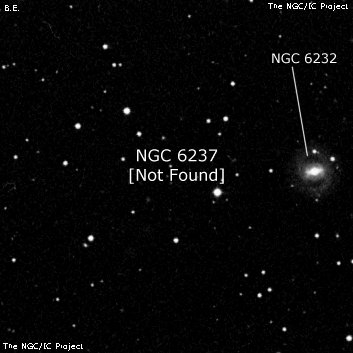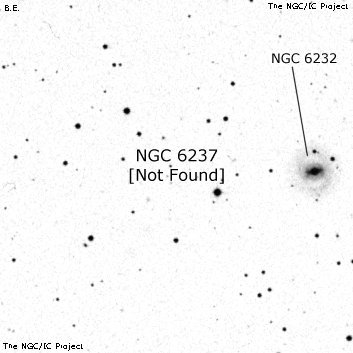NGC/IC Project Restoration Effort
(This is a very very beta version)
NGC6237


Basic Information
Location and Magnitude
Right Ascension: 16:44:7.4
Declination: +70:38:5
Constellation: DRA
Visual Magnitude:
Historic Information
Discoverer: Swift L.
Year of discovery: 1884
Discovery aperture: 16.0
Observational
Summary description: eF, S, E
Sub-type: NF
Corwin's Notes
=====
NGC 6237 and NGC 6245 may be duplicate observations of NGC 6232 and NGC 6236,
respectively. Or they may be stars. Or, they may simply be "not found."
Whatever the case, these are two of a group of four nebulae that Lewis Swift
found on the night of 28 June 1884; the other two are NGC 6232 and NGC 6236.
Over a year later, on 11 August 1885, Swift found another nebula, NGC 6248,
about half a degree south of his group. There were no other observations
before Dreyer compiled the NGC, so he included all five.
Looking at the area on the Sky Survey prints, we now see only three galaxies
here that are bright enough for Swift to have picked up. These are NGC 6232,
6236, and 6248. Swift's RA's for the three are systematically too small by 14
to 31 seconds of time, but his declinations are very good. Looking at his
positions for the missing two objects shows that the declination of NGC 6237
is close to that of NGC 6232, and that for NGC 6245 is similarly close to that
for NGC 6236. In addition, his RA's for the two missing objects each have
roughly the same offset from the RA's for the same two galaxies (32 seconds in
the first case, 48 seconds in the other).
So, I wonder if NGC 6237 = NGC 6232 and NGC 6245 = NGC 6236 -- in spite of the
fact that Swift found all of the objects on the same night, and explicitly
noted "1st of 4," "2nd of 4," etc, in the descriptions of all four objects.
Keep in mind his method of finding positions: centering the object in the
eyepiece, and reading the setting circles. Did he perhaps bump the telescope
or setting circles inadvertantly after reading positions for the first two
objects?
Still, he used a very large field eyepiece, so it may be that he mistook stars
near the galaxies as other nebulae. Or, he may have seen reflections of stars
out of the field and mistook them as nebulae. Or, his eyes may have played
tricks on him if he was tired. I favor the jarred telescope/setting circle
hypothesis, but would not bet even a nickel on its being right.
Whatever happened, the two objects -- NGC 6237 and NGC 6245 -- do not exist on
the sky, so I've simply entered them as "Not found" in the table.



